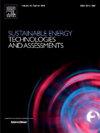Assessing the provincial renewable energy generation efficiency in China considering the energy justice and sustainable development
IF 7.1
2区 工程技术
Q1 ENERGY & FUELS
Sustainable Energy Technologies and Assessments
Pub Date : 2024-11-19
DOI:10.1016/j.seta.2024.104086
引用次数: 0
Abstract
The rapid increase in renewable energy (RE) installed capacity and the resulting issues of energy justice and RE generation efficiency (REGE) require urgent attention. Therefore, this study calculated the China’s RE justice indexes (REJIs) and the provincial RE justice contribution degree from 2012 to 2021 via the Gini coefficient and modified coupling cooperation degree model. Hydropower, wind, and solar power generation efficiencies (HPGE, WPGE, and SPGE) were evaluated using the super-efficiency slack-based measure model. The results show that the REJIs of wind and solar power demonstrated an increasing trend, whereas that of hydropower slowly declined in the following order: wind power > solar power > hydropower. The HPGE fluctuated without remarkable change. The WPGE and SPGE gradually increased, but the SPGE increased rapidly. Furthermore, the Global Malmquist-Luenberger productivity index results revealed that the HPGE and SPGE were driven by efficiency change (catch-up effect), whereas the WPGE was driven by technical change (innovation effect). The REGE exhibited considerable regional heterogeneity. It was the highest in Western China, followed by that in Central China, and the lowest in Eastern China. Our findings can guide policymakers in improving policies to enhance REGE and promote just and equitable energy transition development.
从能源公正和可持续发展角度评估中国省级可再生能源发电效率
可再生能源装机容量的快速增长以及由此带来的能源公正和可再生能源发电效率(REGE)问题亟需关注。因此,本研究通过基尼系数和修正耦合合作度模型,计算了 2012-2021 年中国可再生能源公正指数(REJIs)和各省可再生能源公正贡献度。水电、风电和太阳能发电效率(HPGE、WPGE 和 SPGE)采用基于超效率松弛度量模型进行评估。结果表明,风能和太阳能发电的 REJIs 呈上升趋势,而水电的 REJIs 则按以下顺序缓慢下降:风能> 太阳能发电> 水电。HPGE 波动不大,没有明显变化。WPGE 和 SPGE 逐渐增加,但 SPGE 增加迅速。此外,全球 Malmquist-Luenberger 生产率指数结果显示,HPGE 和 SPGE 受效率变化(赶超效应)的驱动,而 WPGE 则受技术变化(创新效应)的驱动。REGE 显示出相当大的区域异质性。中国西部地区的 REGE 值最高,其次是中国中部地区,而中国东部地区的 REGE 值最低。我们的研究结果可以指导政策制定者改进政策,提高 REGE,促进公平公正的能源转型发展。
本文章由计算机程序翻译,如有差异,请以英文原文为准。
求助全文
约1分钟内获得全文
求助全文
来源期刊

Sustainable Energy Technologies and Assessments
Energy-Renewable Energy, Sustainability and the Environment
CiteScore
12.70
自引率
12.50%
发文量
1091
期刊介绍:
Encouraging a transition to a sustainable energy future is imperative for our world. Technologies that enable this shift in various sectors like transportation, heating, and power systems are of utmost importance. Sustainable Energy Technologies and Assessments welcomes papers focusing on a range of aspects and levels of technological advancements in energy generation and utilization. The aim is to reduce the negative environmental impact associated with energy production and consumption, spanning from laboratory experiments to real-world applications in the commercial sector.
 求助内容:
求助内容: 应助结果提醒方式:
应助结果提醒方式:


